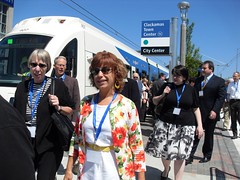
|
Today was the first VIP ride on the Green Line and I had the chance to join anybody and everybody involved in transportation in the region to ride out to Clackamas Town Center.
My biggest overall impression was probably looking at the system map and reflecting on how much of the region is now connected by rail…
Photos after the jump.
P.S. Look for video from Bob later…
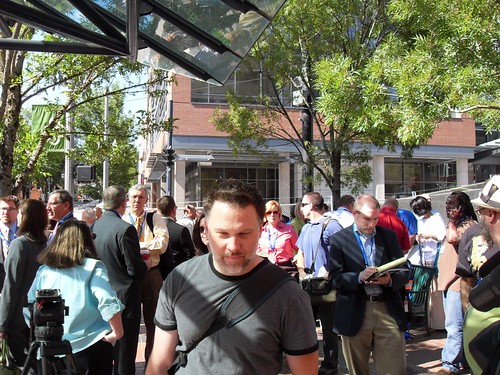

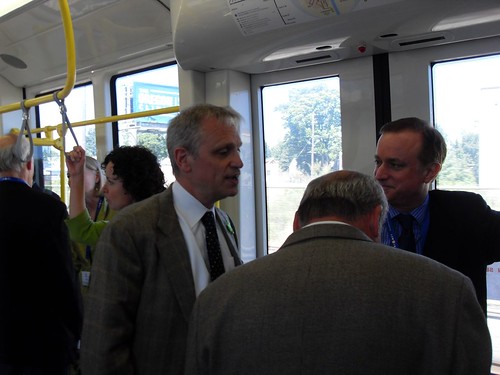
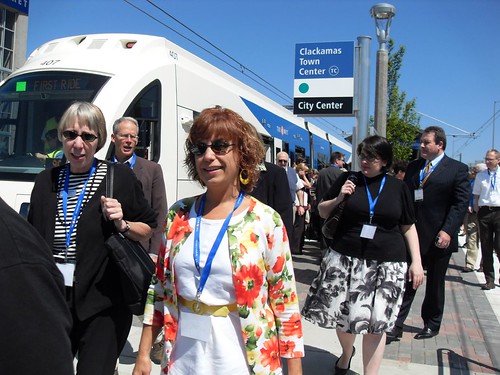
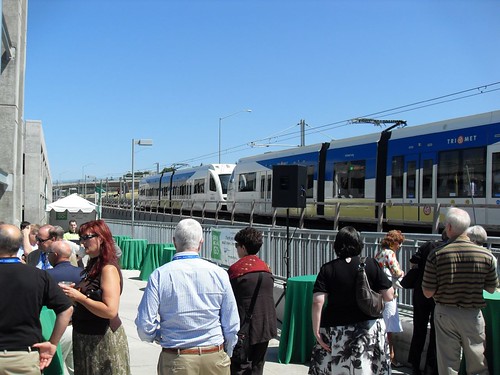
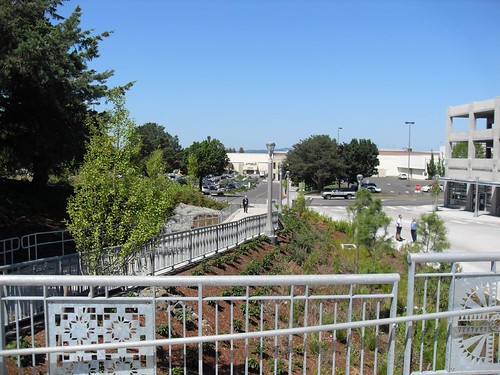
19 responses to “Impressions from the Green Line”
so would one assume ray lahood will check it out tomorrow?
This is great news! Next step Milwaukee! And then out King City on Hwy 99!
So when do the traffic jams on I-205 abate?
Should be fun to watch! (concealed snicker)
P.S. Look for video from Bob later…
I snagged a couple of interviews which may be of interest, but I won’t have a chance to edit the footage until Thursday or Friday at the earliest.
So when do the traffic jams on I-205 abate?
Should be fun to watch!
What’s fun is watching the traffic jams as you cruise past them on the MAX. (Assuming you even bother to look up from the book or newspaper that you’re reading during your morning commute.)
Traffic jams are not likely to abate on I-205; just like traffic jams still exist on I-5, I-84, and US 26. The presence of MAX lines along these corridors probably improves things, as a significant fraction of MAX riders would be otherwise making the same trip in an automobile, but the only way for highway congestion to be abated is for people not to drive.
The problem with freeways is they don’t scale well. In an ideal world, you can increase the capacity of a three-lane cariageway by 33% by adding a fourth lane; in practice, it seldom works that way. Freeways, especially ones filled with traffic, are highly subject to mechanisms resembling turbulence in a fluid–with the result that even a six-lane carriageway can be turned into a parking lot by a disabled car on the shoulder. And increasing the number of lanes greatly increases the chance that on a given day, there will be a traffic-jam collision or breakdown.
The advantages of MAX are that it’s a separate system–problems on the freeway don’t affect it (and vice versa FTMP). Being in a dedicated right of way and operated by professional drivers and regularly maintained by professional mechanics, breakdowns and accidents are far more rare–they do happen, but most mornings MAX runs without a hitch. And MAX can increase capacity at peadk times by shortening headways–and theoretically by running longer trains, although the configuration of the line downtown currently prevents that. A freeway lane which is seemingly vital at rush hour, becomes superfluous at other times of the day.
“So when do the traffic jams on I-205 abate?”
Doh! hahahaa. That question seems to linger of the “build Interstates” school of thought. I was going to ramble on but I see several have jumped on the point.
“Free” roads don’t ever get rid of traffic jams. It is inherent by the architecture, system, and market of subsidizing such a mode. Get used to the traffic jams, I’ll smile while I glance up every once in a while… enjoying my paper too.
Ron:So when do the traffic jams on I-205 abate?
ws:I don’t think LR or even new highway lanes should be sold as reducing congestion or “solving” traffic. This equation cannot be solved.
However, it would be unfair to measure the congestion relief effectiveness of the Green Line on I-205 because it does not span the entire length of the roadway.
People say all the time that the Westside Blue line didn’t reduce congestion on highway 26, as they casually point to traffic on that route. However, one could imagine just how bad it might be had no LR line been built in the first place. Not to mention much of 26 has been expanded in the last 5 years, and any traffic seen on that road is from trying to merge to 405.
boy , E-scotty you got it right when you said ‘professional drivers’ If we let idiots drive cars then it will always suck.
Put down your cellphone and drive people!
Heh…
maybe one way to reduce congestion would be to dramatically tighten the requirements to get a driver’s license. Right now, the legal ability to operate a motor vehicle is widely viewed as a right which all (above 16) should be allowed to enjoy, unless proven otherwise. But a significant fraction of those who drive are of questionable skill or temperament–everyone but myself, it seems :).
Imagine the social impact (on congestion, on transit use, etc). if the the requirements for a drivers’ license were essentially the requirements for a commercial DL; and all but the most minor moving violations were grounds for suspension.
Won’t happen, of course–but it’s an interesting thought nonetheless.
I wanted to go on the ride as part of the media, but I forgot when it was (I had heard at the board meeting–which is the next video for me to upload–that they were going to have it). However, I was at the TriMet Library getting other stuff ready to put online.
Also, I generally agree with the other comments about reducing highway congestion. Especially as the highways are under-priced, there’s usually going to be someone that takes the place of anyone who starts using MAX instead. In addition, I think it might be possible to widen a highway enough to actually eliminate congestion, but that doing so is unfeasible.
The more you widen a highway, the more entrance and egress from that highway become difficult. This can be mitigated with use of C/D roads or express lanes, but adding such structures makes it more and more expensive.
“What’s fun is watching the traffic jams as you cruise past them on the MAX. (Assuming you even bother to look up from the book or newspaper that you’re reading during your morning commute.)”
I’m having even more fun watching you poor suckers go to work to pay the taxes for whatever mode we are using! Most of my driving isn’t during commuting hours these days.
“He who laughs last, laughs best” (Chinese proverb)
Daniel Ronan Says:
This is great news! Next step Milwaukee!
Lance Says:
Wow…a line running all the way to Wisconsin sounds a bit ambitious to me! ;)
I can see the debate now….should it be built along the I-85 corridor, or along Highway 26.
I don’t think Interstate 85 touches either Milwaukee or Portland. (One typo flame deserves another, after all…)
I always find it rather ironic that the people who will benefit from the new line (the riding public) are never invited to these events.
I always find it rather ironic that the people who will benefit from the new line (the riding public) are never invited to these events.
It is my understanding that a number of non-officials were invited, from lists of those who have given input on various committees and at various events. While not randomly-selected members of the public, they are at least stakeholders interested in the outcome of the process. But you can’t fit everyone on just one preview ride… Like similar lines in the past, I expect there will be a well-publicized opening-day event where anyone who shows up can ride.
I find the route of the green line to be grossly flawed because it runs on top of the path of the blue and red lines for much of its route, thereby decreasing its effective coverage. Think how great it could have been if it went down Powell or some other east-west route. Now, of course I’m aware that it’s much easier to use existing right-of-way on the I-84 corridor, but still it’s a lost opportunity to cover more territory in SE Portland.
Now, the other thing I dislike is the massive parking garages that will exist right next to many of the stations. The idea about public transit is that it makes the land adjacent to the stops very valuable, and now we’ve just thrown it all into free parking. Yet another huge driving subsidy!*
*As an infrequent driver and daily cyclist, I’m tired of my taxes paying for all these suburban car commutes. If anyone wants to talk about public transit subsidies, by far the biggest drain on our budget (aside from stupid wars in oil-producing countries) is the highway and local road system, which the gas tax pays only a fraction, and all the free parking, which displaces taxable property such that our rates are so much higher. If you drive, pay your way, and pay for the space your car takes up when you get there. Fair is fair.
“I find the route of the green line to be grossly flawed because it runs on top of the path of the blue and red lines for much of its route, thereby decreasing its effective coverage. Think how great it could have been if it went down Powell or some other east-west route. Now, of course I’m aware that it’s much easier to use existing right-of-way on the I-84 corridor, but still it’s a lost opportunity to cover more territory in SE Portland.”
Historically, that’s “not how it works”. There’s a strong incentive to reuse “core” routes at first to save on capital. You’ll get that SE Portland route eventually, just not yet…
Instead, once the “core section” Steel Bridge-Gateway is filled to capacity — perhaps after yet another East Side line is added — *then* Portland will build a new “Southern Trunk” route.
Look at the Transit Mall. First, all of MAX took the same route through downtown; when that got too crowded due to branches, they built a *different* route through downtown hitting *different* locations.
This is how many metro systems evolve. In London, the Jubilee and Bakerloo lines were formed by taking branches of the Metropolitan line and adding them to a new “middle” section; the Picadilly Line was formed by doing the same thing to branches of the District line. It’s very common to start with one “core” route with branches, and build another “relief” route through the middle, using some of the branches, when the branches start to overload the core. The Chicago Subways were relief routes for the Loop, for another example. An extreme example is Victoria Station in London, which exists as a relief station for Waterloo.